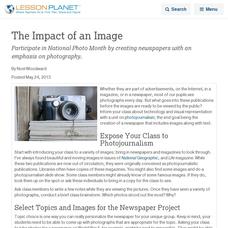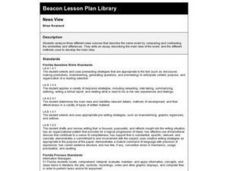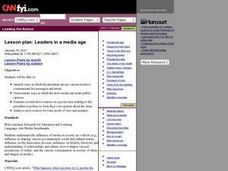Curated OER
The Impact of an Image
Participate in National Photo Month by creating newspapers with an emphasis on photography.
Equality and Human Rights Commission
Influencing Attitudes
Does propaganda—like that used during the first World War—exist today? The 11th lesson in a series of 12 highlights the role of media when it comes to influencing attitudes. Scholars learn about sensational headlines, misrepresentation...
Curated OER
News
Students examine the four main media sources; radio, television, Internet and newspapers, while they determine the reasons that for knowing world news. They write articles to go with given newspaper headlines. They discuss the news and...
American Press Institute
In the Newsroom: The Fairness Formula
Reporting the news is easy, right? Think again! Show young scholars the difficult choices journalists make every day through a lesson that includes reading, writing, and discussion elements. Individuals compare the language and sources...
Administrative Office of the US Courts
Hazelwood v. Kuhlmeier
Freedom of speech is not always free. Scholars investigate how the First Amendment provides for the right to express opinions. Through the court case Hazelwood v. Kuhlmeier, they analyze free speech using primary documents—and hopefully...
Curated OER
Political Cartoons: Literacy
Readers decode and deconstruct political cartoons to heighten critical thinking, extra-textual literacy, and making meaning from symbolism and metaphor. A compatible activity to use in English class when your 8th or 11th graders are...
Curated OER
What's the News?
Students investigate current events. In this current events lesson, students identify current events from newspaper articles and place them on a timeline.
Curated OER
Safety Belts and the Media
Students discuss the importance of using their seat belts in cars. After viewing different public service announcements, they identify ones which made an impact on them. In groups, they draw their own announcement to educate others about...
Curated OER
Media as a Representation of Reality
Students examine different viewpoints and representations of events. They discover that viewpoints are constructed from different points of view. They also examine how they represent real events.
English Enhanced Scope and Sequence
Media Literacy with Focus of Strategies for Collaboration
Introduce your class to literary analysis with a series of activities that has them examine book and movie reviews. Groups then draft their own review of a text, select a digital medium, and craft a presentation.
Curated OER
Conversation Lesson: News
In this conversation lesson worksheet, 7th graders use context clues to get the meaning of 8 words, then select 6 news stories from a list of 12 and explain why they would choose those for an evening TV news broadcast.
Curated OER
Science in the News
Young scholars explore science in the news through articles, magazines, and internet news sites. They select articles, read them and summarize them to identify the audience that would care about their topics. As they present their...
Newseum
Persuasion Portfolios
After class members brainstorm a list of current social and political issues, groups each select a different topic from the list to research. Teams create a portfolio of at least 10 examples of stories about their issue, stories that...
Curated OER
Now That's News To Me!
Students observe how newspapers help to build a sense of community. They identify the important events and people within their school community and create a newspaper page/section. They choose photographs or clippings to use on their...
Curated OER
Blogging to Create a Community of Writers #6: Writing a Review
Looking for a good social media lesson for your class? Then, this lesson is for you! They study various written reviews, then must choose an item to review of their choice. They can choose from: a book, restaurant, CD/musical...
Curated OER
Photojournalism
Students choose a historical or present-day event to portray through photographs. They narrate this event with photographs and text to communicate its significance in history or our current daily lives.
Curated OER
The Student Cafateria as the "Leafy Chestnut Tree"
Students examine the difference between "news" of earlier periods, and "news" as we know it today. They then go out into the school common areas and analyze news from the perspective of word-of-mouth storys and discuss what they can...
Curated OER
Responsible Youth in the News
Students research newspapers and magazines for articles about young people being responsible or being irresponsible. In this responsibility lesson, students discuss responsibility and the articles. Students answer questions in groups...
Curated OER
News View
Students read and analyze three different news sources that describe the same event. They compare/contrast the similarities and differences of the news sources, and write an essay describing the main event.
Curated OER
Cartoons for the Classroom: Watchdogs
Use this political cartoon as a class warm up or discussion starter. Upper graders examine the role of newspapers as government watchdogs. Items for consideration are available, alongside a vivid cartoon.
Curated OER
Life as a Legend: Marilyn Monroe: What is Beautiful?
Students consider the notion of beauty and what impact the media and popular culture have on it. In this cross curricular activity, students examine print ads, write down and share their thoughts on them. Then students form literary...
Curated OER
Leaders in a Media Age
Students identify ways in which the president can use various media to communicate his messages and intent. They demonstrate ways in which the news media can create public opinion.
Media Smarts
Bias
See how bias operates firsthand. Half of the class reads one article while the other half reads another article on the same event. The obvious differences emerge when the two sides talk about their observations though. Several handouts...
Franklin D. Roosevelt Presidential Library & Museum
Pearl Harbor Activity #5: The Medium Matters
Young journalists learn that how we get our news and information matters in a collaborative social studies activity. The class is divided into three groups with the first analyzing a transcript of FDR's "Day of Infamy" speech, the second...

























